
Topics
Guests
- Basir Bitamentor with Afghan Youth Peace Volunteers whose brother survived an attack at the Sayed Ul-Shuhada high school in Kabul.
- Zaher WahabAfghan American professor who taught for four decades at Lewis & Clark Graduate School of Education and for seven years at the American University of Afghanistan in Kabul.
At least 85 people, mostly young girls, were killed in Afghanistan after several bomb blasts outside a school in the capital Kabul. Survivors said the bombs were timed to go off as the girls left school for the day. The neighborhood where the attack occurred is mostly populated by the minority Hazara Shia community, and the Afghan government blamed the Taliban, though the group denies responsibility. The massacre came one week after U.S. and NATO forces started their military withdrawal from Afghanistan and amid a surge in violence. We go to Kabul to speak with Basir Bita, a mentor with Afghan Youth Peace Volunteers whose brother is a survivor of the attack, and Afghan American scholar Zaher Wahab. “Women and children continue to be the main victims of this occupation and invasion and the mayhem,” Wahab says, but he dismisses justifications for the U.S. invasion and occupation of Afghanistan as “protecting women and girls.”
Transcript
AMY GOODMAN: This is Democracy Now!, democracynow.org, The Quarantine Report. I’m Amy Goodman. You can sign up for our daily news digest by emailing the word “democracynow” — without a space, “democracynow” — text that word to 66866 today, and you’ll get our news alerts and daily headlines.
This is Democracy Now!, as we go to Afghanistan. At least 85 people, mostly young girls, were killed after several bombs exploded outside a school in the capital Kabul Saturday. Survivors said the bombs were timed to go off as the girls left their classrooms.
SURVIVOR: [translated] The school time was over, and we were coming out, when a car exploded in front of us.
AMY GOODMAN: Devastated families buried their loved ones amidst mounting despair and anger.
MOHAMMAD SADIQ: [translated] She was 15 years old and in eighth grade. She was very intelligent and didn’t miss a single day of school. Yesterday her mother told her to not go to school, but she said, “No, mother, I will go today but not go tomorrow.” She told the truth, and we buried her today.
AMY GOODMAN: The blasts occurred in a neighborhood of Kabul mostly populated by the minority Hazara Shia community. The Afghan government blamed the Taliban, but the group denied responsibility. The massacre came one week after U.S. and NATO forces began their military withdrawal from Afghanistan and amidst a surge in violence. Elsewhere in the country, at least 11 people were killed and dozens, including women and children, were injured in a bus bombing in southern Zabul province late Sunday.
Meanwhile, a new report has found 40% of all civilian casualties from airstrikes in Afghanistan in the last five years were children. The organization Action on Armed Violence estimates U.S. and Afghan airstrikes have killed 785 children and injured 813 since 2016.
We go first to Kabul, Afghanistan, where we’re joined by Basir Bita, a mentor with Afghan Youth Peace Volunteers. His brother is a teacher who survived the bombing outside his school Saturday.
Welcome to Democracy Now! Can you describe what happened and tell us about the girls? Basir, can you hear me?
BASIR BITA: Yes, I can hear you.
AMY GOODMAN: Ah, OK. Can you tell us about what happened this weekend? Describe this school for girls in Kabul. The death toll is just staggering, at at least 85 right now.
BASIR BITA: Yes. It happened yesterday — two days ago in the afternoon. I was shocked when I heard the story. I quickly tried to reach my brother over phone, and he didn’t pick up when I reached him three times. And I was super shocked. And after a while, I managed to reach to my brother. And he said, “I’m shocked.” He couldn’t speak — his colleagues told me that he couldn’t speak for one hour, too, because he was totally shocked. And yesterday, my wife and I went to the very place that the incident took place. And all I saw was that people, mothers, sisters, brothers, just speaking out, crying, crying and crying. This is a story of [inaudible].
AMY GOODMAN: We’re having a little trouble hearing you. We’re going to try to clear up that line. We’re also on with Zaher Wahab, who’s an Afghan American professor who taught for four decades at Lewis & Clark Graduate School of Education and for seven years at the American University of Afghanistan in Kabul, goes back and forth between Afghanistan and the United States.
Professor Wahab, thanks for rejoining us. You’re a professor of education. Just if you can talk about this school — it is horrifying to say “this target” — and what this means, and what the girls were doing at this school?
ZAHER WAHAB: Yes. Good morning, Amy, and thank you for having me. And I want to commend you for your wonderful journalism.
This was actually not the first time that a school had been attacked. The school is located in what is called Barchi, which is in the western part of Kabul, sort of in the suburbs. And this is mainly populated by the Hazara population, which constitute about a third of the Afghan population and all of them being Shiites. This particular school was a mixed school, and apparently it operates actually three shifts per day, for boys and for girls, and it’s a high school. It’s called the Shuhada high school.
And the explosion occurred — the car apparently was parked at 1 p.m. And when the students were out at 4:30 p.m., somehow word got around that there’s a charity organization in front or near the gate of the school distributing some goods and so forth. And so, most of the girls, hundreds of girls, gathered around at the entrance. And at that point, the car bomb in a Toyota, which was packed with [inaudible] apparently, car explodes. And then, a few minutes, there were two subsequent explosions via IED, improvised explosion devices. So, this is what happened.
And then, of course, you know, you said that some 83 girls were killed and more than 150 were injured. And apparently, the explosion was so strong that some of the students completely evaporated. They disappeared. They couldn’t be found. And then, other than that, you know, people were maimed and dismembered. You know, you found heads without bodies and bodies without heads, limbs and so forth.
And then the people rushed, and apparently this was a mile — a kilometer from a police station. And it took the police station about an hour to respond to the explosion. So, people were very, very angry. When the police and ambulances arrived, some of the people actually began attacking the police and the ambulances and talked to — you know, to sort of curse the government and blame the government for its indifference and lack of attention to the security of the school.
But, as I said, this was at least the third time that a mass murder had occurred in this very same area, which is populated by Hazaras and the poor Hazaras. You know, there was an attack exactly a year ago by a maternity hospital, killing a lot of people. Then there was an attack on a judo club where a lot of people were killed. And then there was an attack in the last year on a main tutoring center where a lot of students were killed. But we should also point out that just in the last few months, there was a major attack on Kabul University in the city itself, in the capital, on the law school, which killed at least 24 students. And then, on April 1st, there was an attack, a car bomb attack, on high school graduates who had gathered in Logar province, which is not very far from Kabul, and they were getting ready to take the entrance examination. So, such mass murders or massacres are sort of the usual thing in Afghanistan, unfortunately, other than the targeted assassinations all over the country of judges, lawyers, professors, journalists, civil society people, and also the war that is currently raging in 13 states.
So, I will stop there, but also I want to point out that one glimmer of hope seems to be that just last night, both the Taliban and the government announced a three-day ceasefire to take place during the Eid al-Fitr.
AMY GOODMAN: One of the early justifications, Professor, for the invasion of Afghanistan was protecting women and girls from Taliban misogyny. I remember Laura Bush would often come out to talk about this. You’re highly critical of this pretext. What is your message to those who say now, “See, the U.S. has to stay in Afghanistan once again to protect girls”?
ZAHER WAHAB: I think this is sort of wrong, and it’s not really exactly true, because if you look at the statistics in the last 20 years, a lot of women and a lot of children, as you pointed out, have been killed. But also, right now there’s no safety or security anywhere. I mean, it’s very interesting to read the United States State Department advisory, you know, which advises Americans to leave Afghanistan but also advises Americans and others not to go to Afghanistan. And the advisory lists, you know, specifically, all kinds of places — schools, universities, clubs, restaurants, mosques, sports events, etc. — that these are all all over the country unsafe and that people should not go to Afghanistan.
But also, you know, we should remember that the initial assault on October 7, 2001, by the United States was really a retaliation. You know, it wasn’t a planned action or invasion or occupation, I should say. But it was simply a reflexive response to the crime of 9/11. So, later, of course, the American government had to have these justifications, and the liberation of — so-called liberation of women was one thing.
But we have to point out that women continue — women and children continue to be the main victims of this occupation and invasion and the mayhem. If you look at, for example, 85% of the women in the country are still illiterate. Child marriage is very common. Polygamy is very common. And poverty amongst women is very, very common. And altogether, 70% of the people are poor. So, whether it was the so-called liberation of women or ending the narcotics or bringing peace, prosperity and democracy to Afghanistan, all of these were, I think, sort of for television, for the American audience, because the facts on the ground are entirely different.
And it is very questionable, and it’s being said by observers: What happened to the $135 billion aid package by the United States? And where is the development? Because, you know, right now most people — and women, in particular — live in the Middle Ages. You know, they’re poor. They’re widowed. They’re, you know, brutalized. And it’s not really true, although a few women, we should point out — a few women in the major cities are going to school, and some to the universities, and have government jobs and travel. But for most women, like most Afghans, people live in pain and suffering.
AMY GOODMAN: I want to see if we can — if we have a clearer line with Basir Bita, again, mentor with Afghan Youth Peace Volunteers, your brother just barely surviving this attack on the girls’ school in Kabul. The Taliban have not claimed responsibility, though they have been blamed for this. Who do you think is responsible? And overall, the significance of the U.S. leaving?
BASIR BITA: You know, there are different stories. Like, I’m hearing different stories from different sources saying that — some claim that the ISIS or Taliban are responsible for the incident, but some other people claim that the responsibility goes to the central government, because, you know, almost two or three weeks ago, I remember clearly, at the same school that the incident took place, along with one or two other schools in the area, the students and the teachers and school administrators ran onto the streets and shouted out that “We need more resources. We need textbooks. We need teachers.” They lack facilities, educational facilities. And you would see that within three or two weeks, such a big incident takes place on the very school that the students and teachers rallied on the streets. And it’s unclear who is responsible for this incident.
AMY GOODMAN: Human Rights Watch has put out a statement warning that groups should not be abandoning support, financial support, for women, warning Afghan women’s access to healthcare is at risk due to cuts in international aid. The group said, quote, “donors are locked in a waiting game to see whether the withdrawal of foreign troops will result in the Taliban gaining greater control of the country. But this is no excuse for cutting funds for essential services that aid groups have managed to deliver in insecure and Taliban-controlled areas.” So often these nonprofits will link up with the military. And when a military leaves, the nonprofits also leave. They find it harder to get funding. Your final comment, Basir Bita?
BASIR BITA: That this is a vicious circle that has been played since the U.S. invasion in 2001. How long are we going to need for the U.S. involvement, financially, economically, politically and militarily, in Afghanistan? There was no development plan. There was no clear action plan for Afghanistan when the U.S. planned to invade Afghanistan. And it is still — I believe that the final solution will be the involvement of Afghan people, Afghan government, civil society organizations and activists, along with the Taliban and other insurgent groups, to come up with a very clear, useful and applicable plan for the future of Afghanistan.
AMY GOODMAN: Basir Bita, I want to thank you for being with us, mentor with Afghan Youth Peace Volunteers. His brother is a teacher at the high school in Kabul, Afghanistan, who survived Saturday’s attack. Thank you for joining us from Afghanistan. He visited the site over the weekend. And Zaher Wahab, Afghan American professor, speaking to us from Portland, Oregon.
When we come back, we speak to Ari Berman about the latest Republican attacks on voting rights, the voter suppression laws that are being passed in state after state in this country. Stay with us.

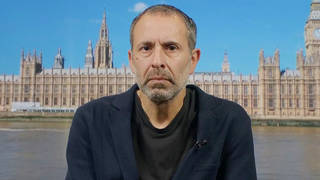
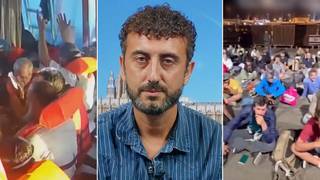
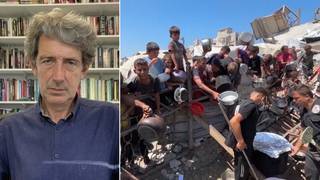
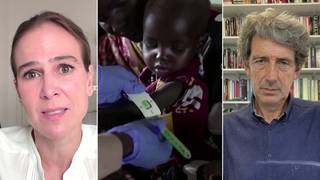



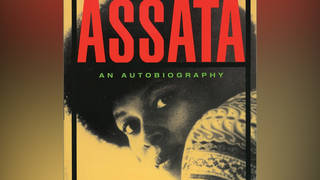



Media Options